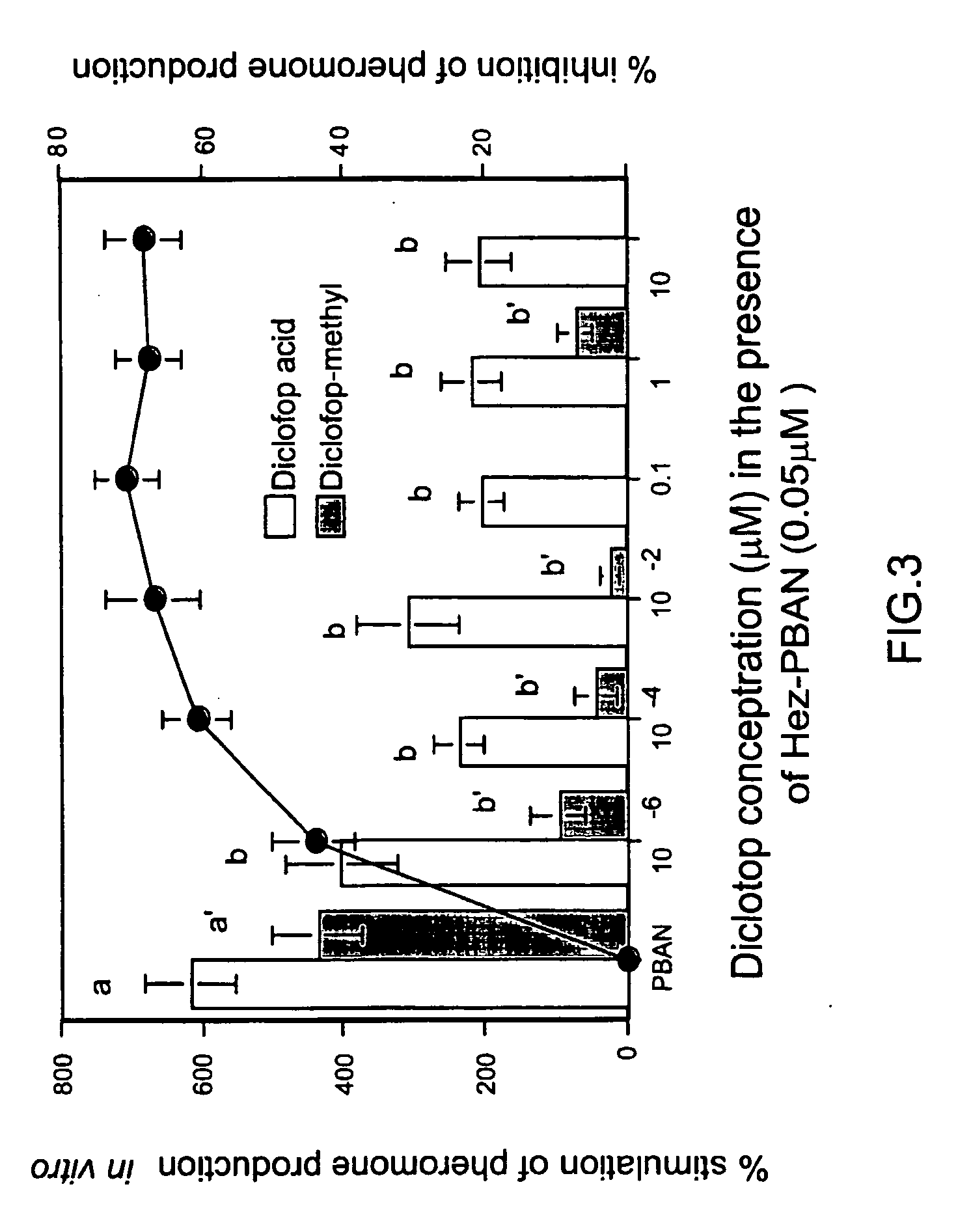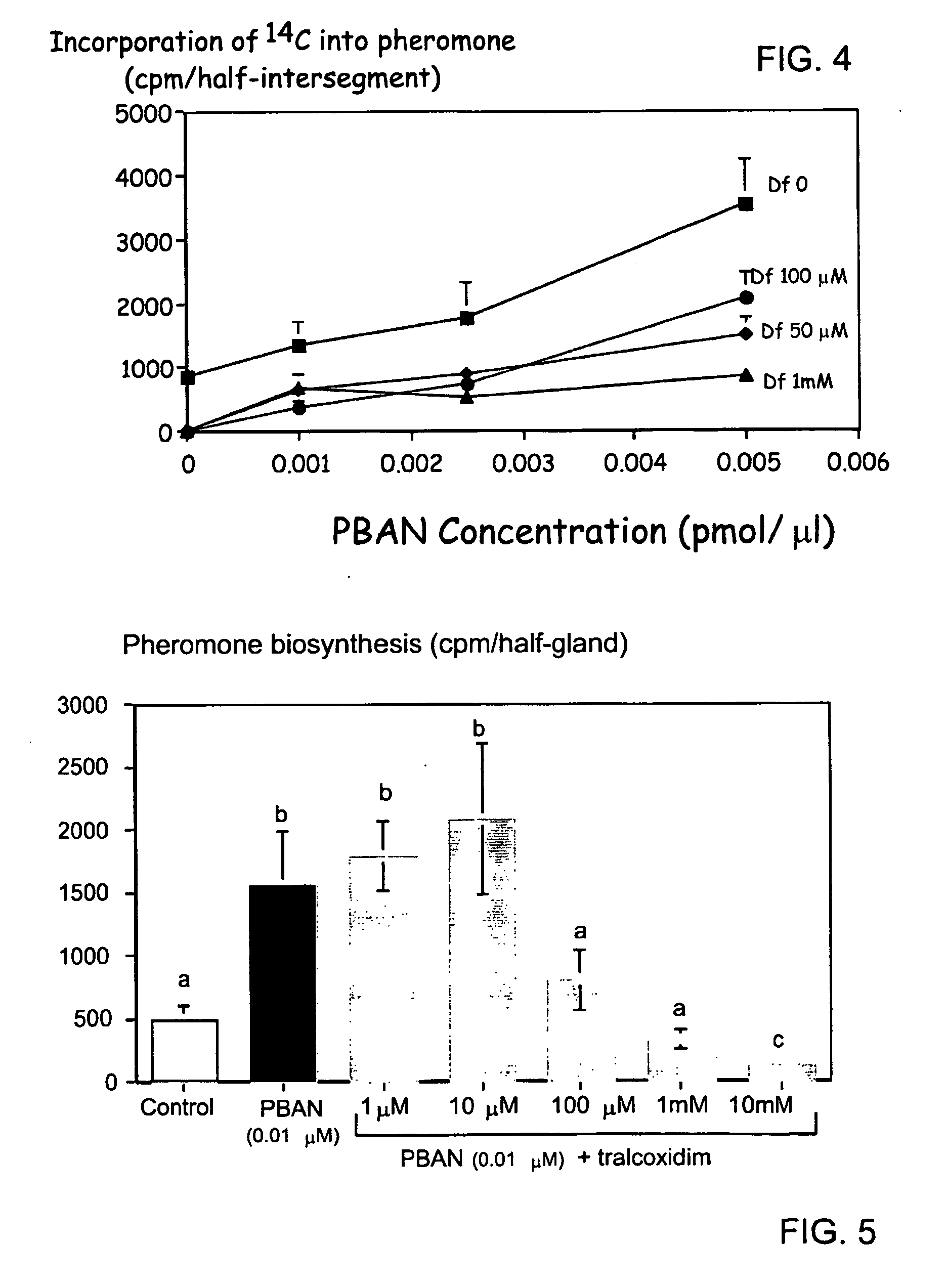Acetyl-CoA carboxylase inhibitors for use as pesticides
a technology of acetylcoa carboxylase and inhibitor, which is applied in the field of acetylcoa carboxylase inhibitors for use as pesticides, can solve the problems of female non-receptivity, disruption of reproductive behavior, and disruption of mating
- Summary
- Abstract
- Description
- Claims
- Application Information
AI Technical Summary
Benefits of technology
Problems solved by technology
Method used
Image
Examples
example 1
Pheromone Biosynthesis and Its Inhibition by Diclofop and Tralkoxydim In Vitro
[0058] Intersegmental membranes (pheromone glands) between the eighth and ninth abdominal segments were removed from 2-3 day old virgin females. After 1 h preincubation in Pipes buffered incubation medium (pH 6.6), pheromone glands were dried on tissue paper and then transferred individually to 10 μl incubation medium containing 0.25 μCi [1-14C]-acetate (56 mCi / mmole, NEN, Boston, USA) in the presence or absence of Hez-PBAN (Peninsula Labs, Belmont, Calif., USA) and in the additional presence or absence of either diclofop acid or diclofop methyl ester (FIG. 3). The effect of tralkoxydim on the activity of H. armigera sex-pheromone glands is shown in FIG. 5. Tralkoxydim (1M) was dissolved in 100% MeOH and serially diluted (MeOH concentrations did not exceed 1%).
[0059] Incubations were performed for 3 h at room temperature. In order to measure the incorporation of radiolabel from [1-14C] sodium acetate, th...
example 2
Pheromone Biosynthesis and Its Inhibition by Diclofop In Vivo
[0060] In vivo sex pheromone production by female moths was determined in 2-day old females. The females were decapitated during the photophase of day 1 and subsequently maintained for an additional 24 h, after which they were injected with either physiological saline (control) or 1 pmol / moth Hez-PBAN in saline, and in the additional presence or absence of diclofop acid. Ovipositor tips (containing pheromone glands) were removed 2 h after injection and extracted for 10 min in hexane, containing 25 ng tridecanyl acetate (Sigma, USA) as internal standard. The hexane extract was concentrated to 2-3 μl final volume under a slow stream of N2 and chromatographed on a 30 m SE-54 fused silica capillary column (internal diameter 0.25 mm) (Alltech, USA) in a Shimadzu HPLC gas chromatographic system. A temperature gradient was performed from initial 120° C. to 270° C. at 10° C. / min, and kept for 15 min at the final temperature. The ...
example 3
Inhibition of ACCase
[0061] The ACCase enzyme was extracted from pheromone glands separated on TMAE column and the eluted enzyme was used. Acetyl CoA was used as a substrate that requires HCO3− where radiolabeled HCO3− was used. In the presence of the enzyme, the substrate will be converted to radiolabeled malonyl CoA (see FIG. 1). Therefore, the difference in the level of incorporation of the radiolabeled malonyl CoA in the presence and absence of the ACCase enzyme was used to obtain the activity level of endogenous ACCase in the presence or absence of herbicides (FIG. 6).
PUM
 Login to View More
Login to View More Abstract
Description
Claims
Application Information
 Login to View More
Login to View More - R&D
- Intellectual Property
- Life Sciences
- Materials
- Tech Scout
- Unparalleled Data Quality
- Higher Quality Content
- 60% Fewer Hallucinations
Browse by: Latest US Patents, China's latest patents, Technical Efficacy Thesaurus, Application Domain, Technology Topic, Popular Technical Reports.
© 2025 PatSnap. All rights reserved.Legal|Privacy policy|Modern Slavery Act Transparency Statement|Sitemap|About US| Contact US: help@patsnap.com



